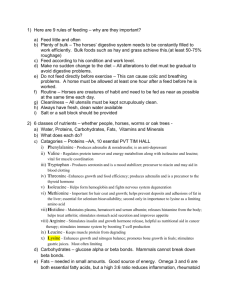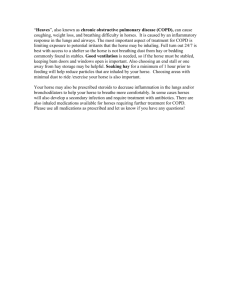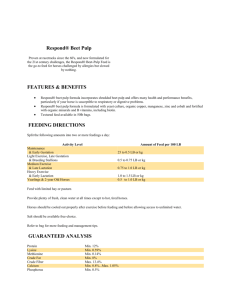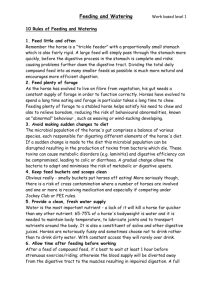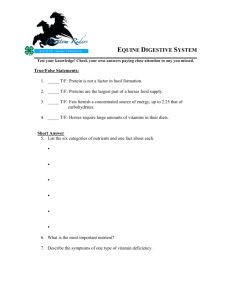Equine Nutrition & Feeding Peggy M. Auwerda
advertisement
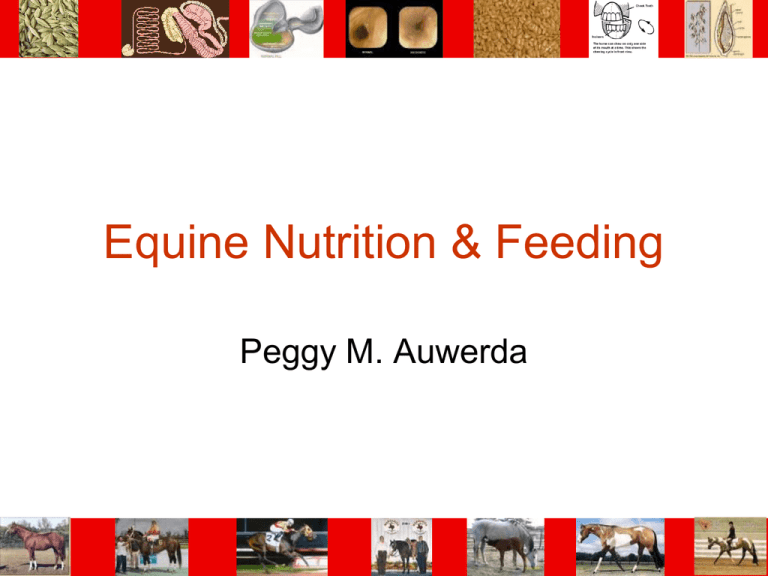
Equine Nutrition & Feeding Peggy M. Auwerda Time-Budgets Feral Horses Select highest fiber, lowest protein content 70% of its day foraging Stabled Horses 10% of their day feeding Meal fed Digestive Tract The Mouth- first part of digestive system. Mouth has 2 main functions- masticate food and wet food with saliva. Mastication •Jaw sweeps 60,000 times/day when grazing •Saliva contains little, if any amylase Digestive Tract Stomach – 9-15 liters Trickle feeders Transit time <2 hr Cardiac sphincter does not relax to allow regurgitation Digestive Tract Small Intestine 30% of digestive tract 40-50 liters Transit time – 45 min to 8 hrs α-Amylase – low & varies widely between horses Starch digestion occurs in the stomach and small intestines Amino acids and fat digested and absorbed in small intestine Vitamins/minerals absorbed in small intestine Digestive Tract Hindgut – 60% of digestive tract capacity Cecum – 25-35 liters Transit time < 5 hr Large Colon 50-60 liters Small Colon 18-19 liters Large & small colon transit time 48-72 hours Fiber digesters most active pH of 6.2-6.8 Starch digesters prefer pH 5.2 – 6.0 Aspects of The Foal GI Tract Small digestive tract The small intestine does not increase in length from 4 wks of age Cecum not fully functional until 15-24 mo of age The large intestine increases with age even up to 20 yrs Microbial Fermentation Volatile Fatty Acids Microbe Fibrous & Non-Fibrous Carbohydrate Gas Metabolized For Energy Wasted Energy B-vitamins & Vit. K Protein and Amino Acids? Starch Starch is an important and valuable component of the equine diet. Equine athletes need carbohydrates for efficient energy use. Mares need carbohydrates to help produce healthy foals. Mares need carbohydrates for milk production. Comparison of Corn and Oats % 90 80 70 60 50 40 30 20 10 0 Corn Oats Starch Fats Protein Small Large Intestine Intestine Digestion Digestion Postprandial Cecal pH Change 7.6 7.4 7.2 Oats Corn Hay 7 6.8 6.6 2 3 4 5 6 7 Starch Overload Starch not digested in SI is delivered to hindgut for bacterial fermentation. Too much starch may… Cause radical changes to hindgut flora Increase VFA & lactic acid concentrations – hindgut acidosis Cause laminitis, colic, endotoxemia, metabolic acidosis, behavioral problems (wood chewing) Critical capacity for hydrolysable carbohydrate overload ~0.4% of BW Cuddeford, D. 1999; Harris et al. 1999 How hindgut acidosis can occur in hindgut and how it can be attenuated High Grain or High Fructans Increase in VFA& Lactic Acid of Hindgut Time Released Buffer Minimal decrease in pH Optimal VFA absorption Optimal Energy for Working & Breeding Horses Significant decrease In pH Decrease in fiber fermenting Organisms Increase in lactate producing organisms Very low pH Bacterial lyses Release of endotoxins Laminitis Subclinical Acidosis Irritation & damage To intestinal mucosa Inhibition of fiber fermenting Organisms & lactate Utilizing organisms Off Feed Decreased fiber digestibility Colic Symptoms Stereotypic Behaviors Pagan, J. 2007. Feedstuffs Carbohydrates Total CHO Non-Fiber Carbohydrates Nonstructural Carbohydrates Neutral Detergent Fiber Neutral Detergent Soluble Fiber Hemicellulose Acid Detergent Fiber Sugars Pectins Cellulose Starches Fructans Lignin β-Glucans Starch Comparisons (what’s low, what’s high) Ingredient NSC % DM Sugar Starch Pectins Beta-Glucans -------------------------- % of NSC --------------------- Alfalfa hay 23.0 0.0 40.9 33.0 Grass hay 17.2 35.4 15.2 49.4 Barley 61.8 9.1 81.7 9.2 Corn 71.4 20.0 80.0 0.0 Oats 42.4 4.4 95.6 0.0 Wheat 73.8 8.9 80.2 10.9 Distillers 10.3 0.0 100.0 0.0 Corn gluten feed 24.7 3.7 71.2 25.1 Corn gluten meal 17.3 0.0 69.4 30.6 Soyhulls 14.1 18.8 18.8 62.4 Soybean meal, 44% 34.4 25.0 25.0 50.0 Wheat midds 31.2 10.0 90.0 0.0 Methods Of Maximizing Starch Digestion In Small Intestine Properties of the starch granule Grain processing Plant cell walls Transit time through the small intestine Availability & concentration of enzymes REMEMBER! “The number one cause of deaths from colic is from starch overload due to feeding mismanagement.” Dr. John Reagor, PhD Chief of Toxicology Texas Veterinary Medical Diagnostic Laboratory Glycemic Response Hyperglycemia occurs after digestion of grain meals Affects substrates utilized during exercise Glucose & insulin peak 60-90 min after a meal Insulin promotes fat storage Sugary meals before exercise will CHO to muscle & ↓ fat oxidation Feeding Horses Feed intake usually expressed as % of Body Weight Lbs feed/100 lbs body weight Free Choice Forages – Maximize in the ration Provide fiber & energy Min. at least 1% of body weight (dm basis) Concentrates Provide energy Supplements Provide protein, minerals and vitamins Estimating Weight (lbs) Heartgirth (in) x Heartgirth (in) x Body Length (in) 330 Energy Determines Weight & Condition Of Horse Body Condition Score Measures amount of body fat (1-9 scale) Determines balance between energy intake & expenditure Simple, repeatable, consistent method Comparison between animals Body Condition Score Fat laid down in predictable patterns Organs Behind the shoulder Ribs Rump Back Withers Head and Neck Body Condition Score Evaluation Visual assessment and actual touch Palpate fat areas Avoid mistaking longer hair covering for fat areas Avoid being fooled by conformation differences Body Condition Scoring 1-3 Poor-Thin 4 Can see ribs, vertebra ridge evident 5 Back flat, can’t see ribs, but can feel them 6 Crease down back, fat deposits 7-9 Fleshy - Extremely fat Time & Additional Grain Required To Improve BCS by 1 level Improving 1 Condition Score Days Needed Daily Gain 60 0.75 lbs/day Additional Grain Needed 4.5 lbs/day 90 0.50 lbs/day 3.0 lbs/day 120 0.40 lbs/day 2.3 lbs/day Optimum Body Condition Score Each horse has its own ideal condition for the breed & use Average horse Broodmare Breeding stallion Performance horse 5-6 5-7 5-6 4-6 Building a Horse Ration Start with horse needs Maximize forage Add energy if needed Add protein & minerals if needed Consider adding vitamins & supplements Consistency is key to good feeding practices Feed concentrate that makes-up the difference between nutrients needed & nutrients in roughage Forages are the Foundation Pasture, Hay Grass Bromegrass Orchardgrass Tall Fescue Timothy Grain Hay Oat Hay Wheat hay Straw Legume Alfalfa Birds Foot trefoil Clovers Lespedeza Ingredients Used In Place of Hay for Roughage Good Quality Sources: Beet Pulp Soybean Hulls Dried Citrus Pulp Dried Apple Pectin Pulp Alfalfa Meal Poor Quality Sources: Peanut Hulls Oat Hulls Ground Straw Cottonseed Hulls Rice Hulls Rice Mill Feed Forage Isn’t Everything Most do not have all the minerals &/or vitamins a horse requires. Four ways to add these. 1. Add 1 to 4 oz mineral or mineral/vitamin supplement per day or 2. Add 1 to 2 lbs ration balancer (mineral plus protein) per day or 3. Feed 5 to 7 lbs fortified grain per day or 4. Feed 12 – 14 lbs complete feed (forage & grain) Energy Sources - Grains Oats Barley variable crimped vs. whole Corn cracked, steam rolled Sorghum & wheat less than 30% rolled, cracked, flaked, Fat/Fatty Acids • No gall bladder Horses can be safely fed up to 20% fat in the total diet Energy from fat is 90% utilizable Often used to supplement calories for hard-working horses and hard keepers Reduction in DM intake & bowel weight Calmer temperament Protein Muscle & bone growth, milk production, fetal growth, normal metabolism Most horses requirements can be met with good quality hay or pasture forage Protein Quantity = amount Quality = amino acid balance Very important for young horses Lysine, methionine, tryptophan most limiting for growth & milk production Sources of Protein for Horses Soybean Oil Meal Flax - Linseed Meal Sunflower Meal Cottonseed Meal Peanut Meal Corn Gluten Meal Whey Dried Skim Milk Minerals Content in the diet Determined by soil & water Quality of feed & proportion of grain to hay Macro-minerals Ca & P - quality forages usually provide adequate amount This ratio is very important: 1.5:1 to 2:1 Grains are rich in P and low in Ca NaCl (Salt) Salt block will meet many horse’s needs If horses sweat a lot - need salt in the ration Trace Minerals Look for iron, zinc, copper, selenium Minerals Macro-minerals – – – Ca & P - quality forages usually provide adequate amount This ratio is very important: 1.5:1 to 2:1 Grains are rich in P and low in Ca NaCl (Salt) Salt block will meet many horse’s needs If horses sweat a lot - need salt in the ration Trace Minerals Look for iron, zinc, copper, selenium A guide to the recommended concentrations of trace elements in the diet, mg/kg dry matter. (Modified from the NRC 2007). These will need to be adjusted to suit individual circumstances, growth rate and appetite etc. Vitamins Fat soluble: - stored in body - A, D, E, K - Toxicity’s can occur if fed in excess Water soluble: - must be continuously supplied - B-complex; niacin, thiamin, riboflavin Vitamins High quality fresh forages = maintenance for mature horses Hay is poor in Vitamin A Supplement Vitamin A in the ration Exposure to sunlight provides Vitamin D Guide to recommended levels of Fat-soluble vitamins (need to be adjusted according to individual circumstances). Nutrient Requirement Varies With Class of Horse – NRC 2007 Adult (no work) Working Light exercise Moderate exercise Heavy exercise Very heavy exercise Stallions Pregnant Mares < 5 mo 5th, 6th, 7th, 8th, 9th, 10th, 11th mo Lactation 1st, 2nd, 3rd, 4th, 5th, 6th mo Growing 4, 6, 12 mo 18 mo Light exercise Moderate exercise 24 mo Light exercise Moderate exercise Heavy exercise Very heavy exercise Water Essential for all body functions Temperature regulation Feed digestion Amount of water intake Level of exercise Ambient temperature Quality of feeds in ration Proportion of diet that is forage Minimum 1 gallon/100 lbs BW/day Maintenance Size: body weight Environment Individual differences Dry matter intake: 1.5% of the BW Most - energy requirements are met with forage alone Recommended Daily Feed Intakes as % of Body Weights Class Forage Concentrate Total Example 1,000 lb horse Mature (Idle) 1.5 - 2.0 0.0 - 0.5 1.5 - 2.0 15-20 lb Geriatric 0.8 – 2.0 0.5 – 2.0 1.5 – 3.0 15-30 lb Geriatric Horses Nutrient Considerations Reduced salivation CF digestibility ↓ Total fiber < 30% CP digestibility ↓ 10-14% CP Energy: Increase soluble carbohydrates, fats, & oils Caloric Restrictions Supplement minerals & vitamins including vitamin C 28 yr old horse Selection of Feed For the Geriatric Horse Highly palatable Easy to chew & swallow Forage - chopped, cubed, pelletized, or in a wafer Grains - rolled, crimped, or flaked 32 yr old horse Feeding The Athlete Aerobic and Anaerobic Metabolism During exercise, ATP is generated from breakdown of: Glucose Fatty acids Amino acids ATP low in muscles; essentially no storage Continuous ATP production vital for athletes Simplified Energy for Muscle Contraction Blood Glucose Free Fatty Acids Lipolysis Muscle Glycogen Lactate Creatine Phosphate Pyruvate ATP Oxidative Metabolism CO2and Water O2 Work ENERGY, ENERGY, ENERGY! Levels of Performance/Work Light – Recreational riding, beginning of training programs, Show horses (occasional) Moderate – School horses, Recreational riding, Show horses (frequent), Polo, Ranch Heavy– Ranch, Polo, Show horses (frequent, strenuous events), Low-medium eventing, Race training (middle stages) Very Heavy – Racing, Elite 3-day event Performance/Work Energy = Activity Maintenance DE (Mcal/d) 16 Light 20.0 Moderate 23.3 Heavy 26.6 Very Heavy 34.5 Feeding Guidelines for Performance Horses Starch is necessary for replacing glycogen stores. Hay Feed at least 50% of total ration as forage (pasture &/or hay) Preferably high quality grass hay or alfalfa/grass mix Exercising horses do not need high levels of protein More important – quality of protein Horses should be fed to meet their immediate needs Cut grain on rest days FAT SUPPLEMENTATION Enhanced stamina capacity for uptake & oxidation of fatty acids in muscle Concomitant decrease in use of endogenous carbohydrate stores Muscle glycogen sparing Add 6-10 weeks before performance Feeding Guidelines for Performance Horses Hay requirement Feed at least 50% of total ration as forage (pasture &/or hay) Preferably high quality grass hay or alfalfa/grass mix Exercising horses do not need high levels of protein More important – quality of protein Horses should be fed to meet their immediate needs Cut grain on rest days Breeding Animals Maiden mare Barren mare Flushing- Increasing energy intake 2025% ~3 wks prior to breeding. Gestating mare Lactating mare Stallion Gestating Mares •Last 3 month of gestation: 60 % foals’ weight •Mare needs to gain 0.3 – 0.8 lb/d Lactating Mare Lactating Mare milk is 3 % BW Month 4 – 6 = milk is 2 % BW Requirements of energy, protein, mineral, and vitamin double vs. maintenance Daily Milk Production (lbs) Month 1 – 3 = 28 27 26 25 24 23 22 21 15 30 45 60 Time (days) 90 120 150 Feed Consumption (% BW) Mare status Forage Concentrate Total Early pregnancy 1.5-2.0 0-0.5 1.5-2.0 Late pregnancy 1.0-1.5 0.5-1.0 1.5-2.0 Early lactation 1.0-2.0 1.0-2.0 2.0-3.0 Late lactation 1.0-2.0 0.5-1.5 2.0-2.5 •Adding concentrate to late pregnancy mares accounts for limited energy & acclimates microbes •Allow 1 wk to 10 d for mares to adjust to intake changes •Heavy milkers may require as much as 1.75-2.0% of BW in concentrate feed/day Body Condition Score Maximum Reproductive Efficiency Moderately fleshy to fat mares can be expected to Cycle earlier in the year Have fewer cycles per conception Have a higher pregnancy rate Maintain pregnancy more easily Mare prior to breeding should have a BCS of 6 or greater and fed to maintain weight. BCS of 5.0 is marginal especially for lactating mare. Feeding The Growing Horse Goals Maximize genetic potential for growth Sound musculoskeletal system •Nutrient Balance is important •Requires higher quality feeds •Growth rate & age determines requirements •Growing till reach 30 months Average Daily Gain 3.5 3 2.5 2 1.5 1 0.5 0 0 2 4 6 8 10 12 14 16 18 20 22 24 Month of Age Nutritional Strategies Aimed at Minimizing DOD Rations should be balanced to promote a consistent growth curve Requires periodic updating of the ration www.Foalcare.com Nutritional Strategies Aimed at Minimizing DOD Feed selection High quality forage is a must Grain mix concentrates formulated specifically for growing horses Improper use of supplements Feed amounts Forage Minimum of 1 lb / 100 lb BW / d Fed to appetite is best Concentrate ~ 1 lb / 100 lb BW / d Max. 8 to 10 lbs /d Monitor The Growth Process Daily Intakes Body Weight Average daily gain Signs of Skeletal Abnormalities Physitis Joint effusion Lameness Feeding Guidelines & Strategies To Minimize Risk Of Hind Gut Dysfunction Know Your Horse & Provide Feed Based on: Class Stage of production Age Activity level Growth Feeding Guidelines & Strategies To Minimize Risk Of Hind Gut Dysfunction Consider.. Quality of feeds available Body Condition Feeding Guidelines & Strategies To Minimize Risk Of Hind Gut Dysfunction Check for Refusals Change type & amount of feed gradually. 7-10 d period Provide Salt Feeding Guidelines & Strategies To Minimize Risk Of Hind Gut Dysfunction Control amount of NSC (sugar, starch & fructan) the horse consumes. Minimize the flow of fermentable polysaccharide to the large intestine Feed starch sources little and often i.e., less than 5g oats/(2g starch)/kg body weight/meal Pre-feed forages Feeding Guidelines & Strategies To Minimize Risk Of Hind Gut Dysfunction Minimize the flow of fermentable polysaccharide to the large intestine Limit rate of concentrate intake through physical obstruction Maximize substrate (glucose) availability to the performance horse Ensure good occlusion of teeth through regular dentistry Feeding Guidelines & Strategies To Minimize Risk Of Hind Gut Dysfunction Group Feeding Should Account for Dominance Hierarchies Recognize Feeding-Related Behavior Problems REINS Relevant Equine Intensive Nutrition Software Peggy Auwerda & Garland Dahke REINS Total mixed ration (TMR) program that allows for evaluation and formulation of protein, energy, vitamin and mineral requirements of horse rations across multiple stages of production Based off of the 2007 NRC Nutrient Requirements of Horses Written in MS Visual Basic and uses MS Excel as the user’s interface to operate REINS Least cost formulator can be used or rations can be entered manually Extensive feed library – Up to 220 feeds Multiple feed libraries can be created which allows a use to assign a feed library to a farm Comprehensive appendixes


